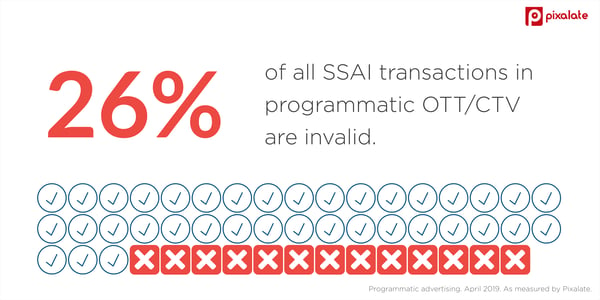
This week's review of ad fraud and quality in the digital advertising space.

Pixalate firmly believes that invalid SSAI is the largest risk factor to OTT/CTV advertising. Using Magna’s most recent OTT ad spend forecasts and Pixalate’s analysis, invalid SSAI alone will threaten $500 million in ad spend by 2020.
Despite these high numbers, the industry at large does not acknowledge that SSAI can be used for fraudulent purposes, and, upon learning of the dangers of SSAI, they don’t know what they can do to protect their investments.
Pixalate is here to help. We are publishing a series of blogs to take a deep dive into all things SSAI, starting with a primer on the topic: What is SSAI, and how can it be abused by fraudsters?

"Programmatic ad tracker Pixalate has some disturbing new evidence that the burgeoning OTT ad marketplace is highly susceptible to fraud," reported MediaPost. "Specifically, fraudsters are abusing the widespread use of 'server-side ad insertion' (SSAI), which is used in 38% of all CTV/OTT programmatic ad transactions," the article noted. "When SSAI is used, Pixalate data shows that it’s fraudulent 26% of the time."

Verve, the leading platform for location-powered programmatic video and display marketing, this week. announced the implementation of Pixalate’s MRC-accredited invalid traffic detection solutions across the full expanse of the Verve VelocityTM platform.
"According to a Q4 2018 study from Pixalate, mobile is especially vulnerable with global fraud rates reaching 20.4% for in-app display and 29.6% for in-app video," the press release reads. "For Verve, integration with Pixalate is a strategic move designed to safeguard clients’ steadily increasing investments in programmatic mobile advertising."

There are "ballooning instances of 'cipher stunting' – a [Transport Layer Security] (TLS) tampering technique that helps malicious bot activity masquerade as live human traffic on the web," reported ThreatPost. "The idea is to avoid the web client fingerprinting technologies that help security tools and human analysts to differentiate between legitimate clients and impersonators/bots," ThreatPost added.

*By entering your email address and clicking Subscribe, you are agreeing to our Terms of Use and Privacy Policy.
These Stories on Weekly Recaps
*By entering your email address and clicking Subscribe, you are agreeing to our Terms of Use and Privacy Policy.

Disclaimer: The content of this page reflects Pixalate’s opinions with respect to the factors that Pixalate believes can be useful to the digital media industry. Any proprietary data shared is grounded in Pixalate’s proprietary technology and analytics, which Pixalate is continuously evaluating and updating. Any references to outside sources should not be construed as endorsements. Pixalate’s opinions are just that - opinion, not facts or guarantees.
Per the MRC, “'Fraud' is not intended to represent fraud as defined in various laws, statutes and ordinances or as conventionally used in U.S. Court or other legal proceedings, but rather a custom definition strictly for advertising measurement purposes. Also per the MRC, “‘Invalid Traffic’ is defined generally as traffic that does not meet certain ad serving quality or completeness criteria, or otherwise does not represent legitimate ad traffic that should be included in measurement counts. Among the reasons why ad traffic may be deemed invalid is it is a result of non-human traffic (spiders, bots, etc.), or activity designed to produce fraudulent traffic.”

